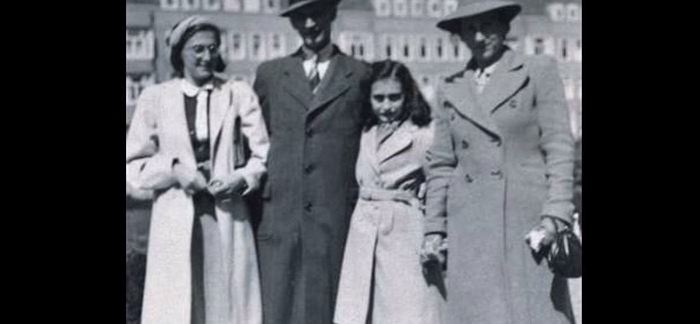Anne Frank is one of the most talked about victims of the Holocaust thanks to her diary and her writings. Her work has become the subject of numerous plays as it documents her experiences of hiding during the occupation of the Netherlands during World War II. She was born in Germany, but lost her citizenship in 1941. Hatred for the Jews started as early as 1932 and Frank’s father Otto, who served in World War I as a Lieutenant in the German military, moved his family to Amsterdam in 1933.
The diary that would become famous was given to Anne for her 13th birthday in June 1942.
Although her story is tragic, there are some interesting facts about Anne Frank that can help to shape our own thinking.
1. Anne Spent Two Full Years in Hiding
It was just 3 weeks after receiving the diary that her sister received a summons to report to a Nazi work camp in Germany. The family decided to go into hiding at that point, living in some of the empty spaces of the work building where her father was a behind the scenes working partner since he couldn’t own a business as a Jew. His business partners and their family helped them hide and provided them with food.
For two years, the family hid together in the dark dampness of the abandoned part of the building. This allowed Anne to write extensively in her diary.
2. No One Knows Who Betrayed the Family
In August of 1944, a secret police officer from Germany, accompanied by four Dutch Nazi officers, broke into the building were the Frank family was hiding. Everyone who was found in the building was arrested. The tip about the family being there came in anonymously and to this day, no one knows who betrayed the family. Anne was sent to Camp Westerbork and then Auschwitz. That’s when Otto was separated from his family, never to see his daughters or his wife again.
Although it was a death camp, Anne and her sister survived several months in difficult conditions while performing hard labor. They hauled heavy stones and grass mats and were then sent to Bergen-Belsen without their mother. Without her girls, Anne’s mother soon fell sick and died shortly afer the girls were transferred.
3. Her Father Had the Diary Published
After returning from the camp, Otto was given his daughter’s diary. It had been discovered and saved by one of his partners. He couldn’t read it at first, but when he did, he couldn’t believe the words that were being written. “There was revealed a completely different Anne to the child that I had lost,” Otto told his mother after reading through it. “I had no idea of the depths of her thoughts and feelings.” He immediately worked to have the diary published.
It was just 3 years after that fateful day of betrayal that the diary was published for the first time. Otto always said that his daughter would have been extremely proud of the accomplishments. It would have made her feel like those deep, dark days in the annex where they stayed in hiding were worth something.
4. The Diary Has Been Published in 67 Different Languages
More remarkable than anything else is the level of acceptance that Anne’s diary has had with the world at large. It’s considered one of the most moving first-hand experiences of the war from a Jewish perspective and her unique ability to tell a story shows a spirit that might bend, but refuses to be broken – no matter what.
“I see the world being slowly transformed into a wilderness,” she wrote just before being discovered. I hear the approaching thunder that, one day, will destroy us too. I feel the suffering of millions.”
“Yet, when I look up at the sky, I somehow feel that everything will change for the better, that this cruelty too shall end, that peace and tranquility will return once more.”
To this date, her diary has sold more than 30 million copies, even though it is on the banned book list and considered controversial by some because of how she talks about her anatomy.
5. A Chestnut Tree Anne Loved Lives On
In her diary, Anne often mentioned a chestnut tree that she adored. In 2009, saplings were taken from this tree and planted in 11 different sites across the United States. One of the sites is at the West Front Law of the US Capitol building.
“The two of us looked out at the blue sky, the bare chestnut tree glistening with dew, the seagulls and other birds glinting with silver as they swooped through the air, and we were so moved and entranced that we couldn’t speak.”
In 2005, it was discovered that the chestnut tree had a serious disease. Supports were given to it so that it could continue to stand, but in 2010 it could go on no longer. The saplings of the tree, however, will continue to bear witness to the bravery of a teenage girl who had so much creativity and love for the world around her.
6. Much of the Diary Is in the Form of Letters
Although there are several people who have letters addressed to them in Anne’s diary, the most popular figure is “Kitty.” Some believe she is writing to her friend from before the war, while others think it might be a reference to her favorite books. Her friend, who was able to survive a concentration camp, said that she doesn’t believe that Anne was writing to her in these dark days.
7. The Officer Who Arrested Anne Bought Her Book
Karl Silberbauer was the arresting officer of the Frank family. He even remembers telling Otto that he had a lovely daughter. He purchased the book after it was published to see if he had been mentioned in it. Here’s a hint – he’s not. “I should have picked it up off the floor,” he said once.
After the war, Silberbauer worked as an officer with the Viennese police. In 1963, when it was discovered that he was the arresting officer of the Frank family, he was suspended from his job. His response? “I have just bought some new furniture and how am I going to pay for it?” An investigation was conducted and he went back to his job.




